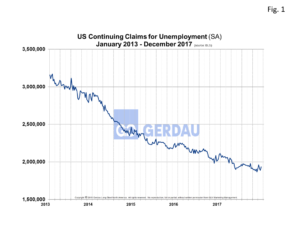Employment: Continuous and New Jobless Claims
Continuous claims as well as new claims for unemployment insurance benefits remain at historic lows. Seasonally adjusted (SA), continuous claims stood at 1.936 million, (M) as of December 9th, down 47,000 week on week, (w/w). The SA four week moving average (4WMA), was a shade lower at 1.924M, down 5,250 week on week and down 114,500 year on year, (y/y).
New SA claims for unemployment insurance were 250,000 for the week ending December 30th, +2,300 w/w. The 4WWA totaled 242,000, down 4,000 w/w. The previous week’s number was revised to 250,000, up 2,000. Note, that new claims are especially volatile at this time of year.
Unemployment insurance claims are a count of recipients by state of benefits mandated by federal law. Initial claims for unemployment benefits provide a proxy for layoffs, whereas continuing claims give a timely sense of the stock of unemployed workers.
 Figure 1 charts SA continuous claims for unemployment from 2013 to present. Continuous claims are at historic lows as illustrated in Figure 2
Figure 1 charts SA continuous claims for unemployment from 2013 to present. Continuous claims are at historic lows as illustrated in Figure 2 , which charts SA initial claims for unemployment insurance from 1990 to present. In fact, we have to go all the way back to the early 1970s to find lower numbers. This small level of initial claims is indicative of a labor market that is in very good health.
, which charts SA initial claims for unemployment insurance from 1990 to present. In fact, we have to go all the way back to the early 1970s to find lower numbers. This small level of initial claims is indicative of a labor market that is in very good health.
The insured unemployment rate was unchanged at 1.4% in the week ended December 23rd. Fourteen states reported an increase in NSA new filings in excess of 1,000 in the week ended December 23rd. California and Puerto Rico reported a decline in NSA new filings in excess of 1,000 in the week over the same timeframe.
The labor market performed well in 2017 and new filing as well as continuous claims continue to decline. Today’s employment report from the BLS reported that job creation in December totaled 148,000, less than analysts’ expectations. November payrolls were revised higher from 228,000 to 252,000, while October payrolls were revised lower from 224,000 to 211,000. These changes essentially cancelled each other out. The unemployment rate was unchanged at 4.1%. The labor participation was also unchanged, at 62.7%, as was the employment-to-population ratio, at 60.1%. Wages grew by 0.3% and by 2.6% y/y.
The economy created 2.055M jobs in 2017, less than the 2.240M in 2016. Looked at monthly, the total was 171,000 per month in 2017, vs. 187,000 per month in 2016. It is probable that job creation will slow in 2018 as the labor pool continues to dry-up.
At Gerdau, we keep a keen eye on the employment numbers because we have demonstrated that there is an excellent correlation between employment levels and steel consumption. High job creation and low unemployment translate to strong steel demand and vice versa.

